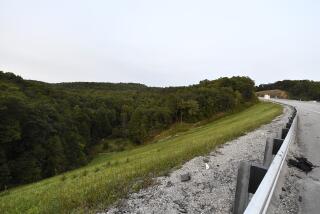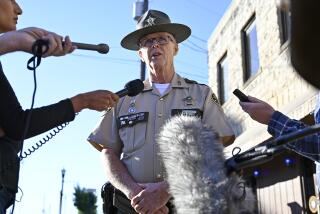Distance Offers Sniper Safe Haven
- Share via
SEVEN CORNERS, Va. -- Distance is the Beltway killer’s lethal edge.
Firing from hundreds of yards away, he remains a phantom to victims and witnesses. Distance provides the element of surprise and the luxury of escape, a cloaking remoteness that has emerged as the most frustrating obstacle for investigators struggling to catch the serial murderer before he kills again.
When the gunman shot his 11th victim Monday night, Ligia Baldivia knew in an instant where the shot came from. The sonic crack echoed out of a darkened school parking lot close to her first-floor apartment.
“I didn’t know it was from this guy until the next day,” she said. “It was so loud, everybody around here heard it.”
But across U.S. 50, a noisy six-lane highway, sniper task force detectives were convinced that the fatal shot had been fired from inside a Falls Church, Va., Home Depot garage. For two days after FBI analyst Linda Franklin was felled near her car, investigators thought the gunman had finally made a critical mistake, surrendering the safety of distance to kill close up.
Then investigators discovered that a primary witness had trumped up a tale that Franklin had been shot from only 40 yards away, and they shifted their focus to the parking lot 100 yards across the highway. It was a return to the painstaking long-range searches that have strained police manpower and complicated evidence-gathering for 18 wearying days.
The gunman’s ability to murder from long distances has forced investigators to expand their crime scenes by hundreds of yards and bogged them down in a tedious hunt for what might be left behind. It also has distorted the sound from the sniper’s high-powered rifle, making it hard to know where the shots are coming from.
“We’re now at the point where we go out on each new case knowing we have a remote crime scene we have to deal with,” one investigator said. “That doesn’t make it any easier to solve.”
Task force officials say the rifle-wielding assailant has fired each of his 11 solitary shots from a distance of 150 to 500 yards. Using high-velocity .223-caliber ammunition, the sniper has tended to fire closer to the 150-yard range in most of the shootings, investigators believe. He has killed nine people and wounded two, and authorities were investigating a Saturday night shooting in Ashland, Va., as possibly connected.
But in at least two cases, one official said, the bullet’s trajectory showed it was fired from so far away that police are still uncertain exactly where the gunman hid.
Distance “makes it hard for us in several ways,” said Douglas F. Gansler, the Montgomery County state’s attorney who heads a team of prosecutors in the five Maryland murders.
“You have fewer witnesses because the sniper isn’t seen,” Gansler said. “The witnesses focus most of their attention on the victim because that’s the only part of the crime they see. And you end up having to deal with two crime scenes -- where the victim was hit and where the shooter fired from.”
If his penchant for targeting people from long range signals a thirst for killing as sport, as some police and serial murder experts say, it also shows a deep sense of caution.
“The farther away you are, the greater the chance you escape undetected,” said Peter Gagliardi, a former federal firearms official who now works as a private forensics consultant.
Investigators believe that, in some instances, the killer may have fired from inside a vehicle -- which could contain valuable crime scene evidence such as powder burns and spent shells. On Saturday, police forensics teams examined a white box truck after being tipped by a cleaning crew that found a shell casing inside. The rental vehicle had just been returned to an agency near Dulles International Airport in Virginia.
Some task force members are exploring the possibility that the killer’s vehicle was moving as he fired -- a difficult feat that suggests an accomplice as driver.
Firing from afar confuses witnesses because, as a bullet travels a long trajectory in a split second, the sound of the gunshot is distorted by “traffic patterns in the street, wind, noise and rain. Sound travels funny,” said Gagliardi, a former head of the Department of Alcohol, Tobacco and Firearms in New York who now is a vice president at Forensic Technology in Washington.
The result is echo, distortion and the mistaken impression that a bullet was fired from one direction when it actually came from another.
That confusion is magnified by the fact that the sniper fires only a single round. “When you have only one shot,” Gansler said, “it doesn’t give witnesses a chance to use a second shot to tell its direction.”
A remote firing site also complicates the search for evidence by giving the gunman time to clean up the evidence around him before he flees.
Jim Pasco, a former federal Bureau of Alcohol, Tobacco and Firearms deputy director who now heads the National Fraternal Order of Police, said that, even outdoors, forensics experts know how to look for critical shell casings and traces of gunpowder on fences, walls, car hoods -- anywhere that a gunman might brace his rifle before firing.
But those efforts can be frustrated if police take days to find the actual firing spot -- a period in which evidence such as powder burns can erode in the wind and rain.
The ATF has used metal detectors and search dogs sensitive to trace amounts of gunpowder to speed the search for powder burns and other residue.
“They’d like to move fast to get all the material they can,” Gagliardi said. “But if they have huge areas to search, they might not find the firing point. Even if they do, it might be too late.”
Baldivia, the Fairfax County resident, and half a dozen other people who live in a maze of red brick apartments directly across U.S. 50 from the Home Depot said police did not question them on the night of Franklin’s murder. Adriana Velasquez, 35, a Salvadoran emigre, said she was not interviewed until the day after, when she went to the Home Depot to leave a votive candle at the parking spot where Franklin died. Baldivia still had not been questioned by detectives by week’s end.
Although Fairfax County police said the false witness did not impede the investigation, it took investigators three days to mount a full-scale search for evidence in the school parking lot.
Police have provided few details of their searches. The scene that yielded the most clues was a patch of woods where detectives found the killer’s perch hours after the sniper shot and wounded a 13-year-old student in Prince George’s County, Md. Police found a shell casing, matted grass and a Tarot card scrawled with a taunting message: “Dear Mr. Policeman, I am God.”
All of those items could become crucial in matching the killer to the remote crime scene -- but only after police make progress in finding a suspect. As long as the sniper stays far out of sight, the amassed evidence remains useless.
More to Read
Sign up for Essential California
The most important California stories and recommendations in your inbox every morning.
You may occasionally receive promotional content from the Los Angeles Times.











